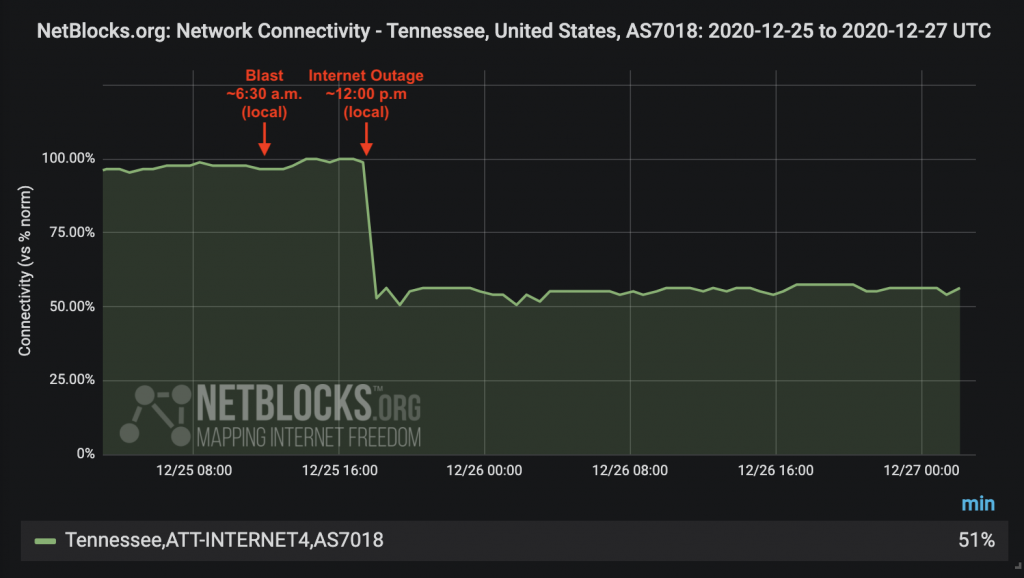Network data from the NetBlocks Internet Observatory confirm that internet connectivity in Tennessee and Kentucky remain impacted for many subscribers some two days after an explosion on 25 December 2020 in Nashville, Tennessee triggered a series of events that knocked AT&T offline. AT&T is a major provider of home and business broadband, fiber and cellular network connectivity in the region, also serving as the backbone for other consumer services and data centers.
Technical data from the observatory corroborate the provider’s assertions that the outage was not caused by the immediate impact of the explosion, but rather linked to secondary impacts attributable to the loss of power hours after the detonation itself. As such, the shutdown of services occurred in the context of efforts by authorities and engineers to secure the blast site, make the area safe and restore power toward the resumption of business.
Service was largely restored by Sunday evening, with a recorded incident duration of 50 hours.
Analysis: Internet has been cut for many AT&T subscribers in and around Tennessee following an RV blast on Christmas Day.
Using network data we examine the circumstances of a ~5 hour disparity between detonation and outage times ⌚️? #NashvilleBombing
? https://t.co/3A9Sia4XqL pic.twitter.com/0kTVrZhXDG
— NetBlocks (@netblocks) December 27, 2020
What happened in Nashville on Christmas Day?
On the morning of 25 December 2020, a parked recreational vehicle detonated around shortly after 06:00 a.m. local time, damaging dozens of buildings on 2nd Avenue, toppling trees and shattering windows in the vicinity of the blast site.
Authorities classed the explosion a probable suicide bombing following the discovery of human remains at the location although a motive was not established at the time of writing. Prior to the explosion, warnings were heard instructing passers-by to evacuate, suggesting that premises and infrastructure may have been specifically targeted in some way or the other.
Balancing safety and public Infrastructure
The extended outage sparked discussion over the role of telecommunications infrastructure in the aftermath of crisis situations. It was indicated that generators supplied backup power for several hours after the blast on the morning of the 25th. Given the disparity of timings, procedures to ensure site safety and protect first responders are understood foremost to have been responsible for the protracted outages which sent thousands offline.
Further, on the evening of Saturday, 26 December an AT&T statement provided updates on efforts to restore connectivity, initially via portable cell towers, but also through the full restoration of power to the affected network operations center.
The update describes efforts to drill a new power source to the site, indicating that power mains may have been severed in the initial blast or otherwise damaged in the aftermath of the explosion, leaving technical infrastructure dependent on a finite backup supply that dwindled and became exhausted in the subsequent hours.
In August 2020, a deadly explosion in Beirut, Lebanon knocked out connectivity across much of the country. NetBlocks analysis attributed the outage to the direct kinetic impact of the blast in that case.
Engineers worked to restore internet access around the clock following both incidents. The two crises serve as a reminder of the risks and challenges telecommunications service operators face in the supply of infrastructure to businesses and the general public.
Update: Real-time network data show that internet provider #TerraNet, situated in proximity to yesterday's catastrophic blast in #Beirut #Lebanon, has made a remarkable recovery back up to 85% connectivity in just one day ??
? https://t.co/rTZJWbKonYhttps://t.co/sDiwDMjPoI pic.twitter.com/cNHGlmHB9X
— NetBlocks (@netblocks) August 5, 2020
Methodology
NetBlocks diffscans, which map the IP address space of a country in real time, show internet connectivity levels and corresponding outages. Purposeful internet outages may have a distinct network pattern used by NetBlocks to determine and attribute the root cause of an outage, a process known as attribution which follows detection and classification stages.
A summary of data visualizations used in this report:
- Network Connectivity (Regional): Internet providers and networks serving the affected region are visualized in a stacked time-series histogram to identify the start and end times of an internet outage event. Scales on the y-axis are adjusted to match localized maxima while minima indicate periods when networks became unreachable. The x-axis represents Universal Coordinated time (GMT+0).
- Standard: Connectivity levels on the y-axis correspond directly to the observed number of reachable connections, as with National Connectivity charts.
NetBlocks is an internet monitor working at the intersection of digital rights, cyber-security and internet governance. Independent and non-partisan, NetBlocks strives to deliver a fair and inclusive digital future for all.
[ press | contact ] Graphics and visualizations are provided for fair use in unaltered form reflecting the meaning and intent in which they were published, with clear credit and source attribution to NetBlocks. Intellectual property rights are protected including but not limited to key findings, facts and figures, trademarks, copyrights, and original reporting, are held by NetBlocks. Citation and source attribution are required at the point of use.

